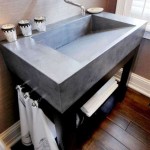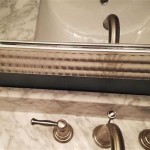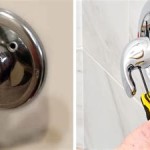How to Fix Loose Bathroom Floor Tiles
Loose bathroom floor tiles can be a common but frustrating issue. Beyond the annoyance of the tile shifting underfoot, a loose tile can be a sign of a more significant underlying problem. Water seeping through cracks and gaps created by the loosening tile can damage the subfloor, leading to mold growth and structural concerns. Therefore, addressing loose tiles promptly is crucial for maintaining the integrity and aesthetic appeal of the bathroom.
Several factors can contribute to floor tiles becoming loose. These include inadequate initial installation, age of the adhesive, moisture exposure, subfloor movement, and impact damage. Poorly applied thin-set mortar during the original installation may not provide sufficient adhesion, leading to tiles detaching over time. Similarly, as adhesives age, they can become brittle and lose their bonding strength. Constant exposure to moisture in the bathroom environment can also weaken the adhesive bond. Subfloor movement, whether due to settling or temperature fluctuations, can exert stress on the tiles, causing them to loosen. Finally, dropping heavy objects or other impacts can crack the tile or weaken the adhesive layer.
Before undertaking any tile repair, assessing the situation is paramount. This involves identifying the extent of the problem, determining the cause of the loosening, and gathering the necessary tools and materials. Careful evaluation will help ensure that the repair is effective and prevents recurrence of the issue.
Step 1: Assessment and Preparation
The first step is thoroughly inspecting the affected area. Identify all loose tiles and note the extent of their movement. Check for any cracks or damage to the tiles themselves. Gently try to lift the loose tiles to ascertain how easily they come up. This will provide insight into the condition of the adhesive underneath. Also, examine the grout surrounding the loose tiles for cracks or crumbling, as this can be another entry point for moisture.
Next, address the potential cause of the loosening. If there is evidence of water damage, determine the source of the leak and rectify it before proceeding with the tile repair. Ignoring the underlying water problem will only result in the tiles loosening again. Check for any subfloor movement by walking around the bathroom and feeling for soft spots or excessive give. If significant subfloor movement is detected, it may require professional assessment and repair before the tiles can be properly re-adhered.
Once the assessment is complete, gather the required tools and materials. These typically include: a utility knife or grout saw, a putty knife or scraper, a bucket or container for debris, a vacuum cleaner, safety glasses, gloves, thin-set mortar, a notched trowel, a rubber mallet, a damp sponge, and sealant or grout.
Protect the surrounding areas with drop cloths or plastic sheeting to prevent mortar or grout from staining or damaging adjacent surfaces. Ensure proper ventilation in the bathroom by opening windows or using a fan. Safety glasses and gloves are essential to protect against debris and potential skin irritation from the mortar.
Step 2: Removing and Cleaning the Tiles
Carefully remove the loose tiles. If the tiles lift easily, gently pry them up with a putty knife or scraper. If the tiles are more firmly attached, use a utility knife or grout saw to carefully score the grout around the perimeter of the tile. This will help to loosen the grout and prevent damage to the surrounding tiles when prying. Work slowly and apply even pressure to avoid cracking the tile.
Once the grout is scored, gently insert the putty knife or scraper under the edge of the tile and gradually pry it up. If the tile is particularly stubborn, try tapping it gently with a rubber mallet to loosen the adhesive bond. Avoid using excessive force, as this could break the tile. If a tile breaks during removal, wear safety glasses and gloves to protect against sharp fragments.
After removing the loose tiles, thoroughly clean both the tiles and the subfloor. Scrape away any remaining adhesive from the back of the tiles using a putty knife or scraper. Use a vacuum cleaner to remove loose debris and dust from the subfloor. This will ensure a clean surface for the new adhesive to bond to.
If there is any mold or mildew present on the subfloor, clean it with a mold and mildew remover. Allow the subfloor to dry completely before applying new adhesive. This is crucial to prevent the growth of mold and mildew in the future.
Step 3: Re-adhering the Tiles
Prepare the thin-set mortar according to the manufacturer's instructions. Add water to the dry mortar mix gradually, stirring constantly until you achieve a smooth, peanut butter-like consistency. Allow the mortar to slake for the recommended time before using it. This allows the chemicals in the mortar to activate and ensures proper bonding.
Using a notched trowel, apply a generous layer of thin-set mortar to the subfloor in the area where the tile will be placed. The notch size of the trowel should be appropriate for the size and type of tile being used. Hold the trowel at a 45-degree angle and spread the mortar evenly across the surface, creating ridges that will help the tile adhere properly.
Carefully place the tile back into its original position, aligning it with the surrounding tiles. Press down firmly on the tile to ensure good contact with the mortar. Gently tap the tile with a rubber mallet to further embed it in the mortar and ensure it is level with the adjacent tiles. Use a level to check that the tile is flush with the surrounding surface.
Wipe away any excess mortar from the surface of the tile with a damp sponge. This will make it easier to clean up the grout later. Allow the mortar to dry completely according to the manufacturer's instructions, typically for 24 to 48 hours, before applying grout.
Step 4: Grouting and Sealing
Once the mortar has fully cured, apply grout to the joints between the tiles. Choose a grout color that matches the existing grout or complements the tile. Using a grout float, spread the grout diagonally across the tile surface, forcing it into the joints. Ensure that all the joints are completely filled with grout.
After applying the grout, wait for approximately 15 to 30 minutes, or as directed by the grout manufacturer, for the grout to set slightly. Then, use a damp sponge to wipe away the excess grout from the tile surface. Rinse the sponge frequently in clean water. Be careful not to remove too much grout from the joints.
Allow the grout to dry completely, typically for 24 to 72 hours, before applying a grout sealant. A grout sealant will help to protect the grout from moisture and stains, extending its lifespan and preventing future problems. Apply the sealant according to the manufacturer's instructions, typically with a small brush or applicator sponge.
Finally, clean the entire bathroom floor with a mild detergent and water. This will remove any remaining grout haze or sealant residue. Allow the floor to dry completely before using the bathroom.
In summary, addressing loose bathroom floor tiles requires a systematic approach encompassing assessment, removal, cleaning, readhesion, and grouting. Following these detailed steps helps ensure a durable and aesthetically pleasing repair, mitigating the risk of future complications and preserving the integrity of the bathroom floor.

Fixing Loose Floor Tiles And Why They In New Builds

How To Fix A Loose Floor Tile Without Removing It

Tile Repair Loose Tiles Part 1 How To Identify And The Proper Way Remove Them

How To Fix Loose Hollow Tile Floors Don T Remove Or Replace Just Drill Fill
.png?strip=all)
How To Fix Loose Or Broken Ceramic Floor Tiles

Loose Floor Tiles Here S How To Fix Them Fast And

How To Fix Loose Floor Tiles Alliance Flooring Directory

Repairing Loose Hollow Tiles On Underfloor Heated Areas Tsj

How To Fix Loose Tile Tips And Tricks Rubi Blog Usa

Removing Popped Tiles And Putting Them Back Down
Related Posts







